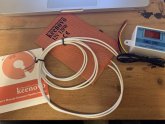In addition to my previous post.
According to the specs of the cells we just need a temperature controlled heating pad when giving load into the battery. Discharging is possible having much lower temps. Doing so we could save much energy.
So, in my opinion it could be an idea to interpose an adjustable undervoltage protection between the temperature controller and the heating pads. Something similar to this (
https://www.aliexpress.com/item/-/32857358407.html?spm=a2g0s.8937460.0.0.7e552e0eWAHUrU).
In theory the temperature-controller would only pass current to the undervoltage-controller having the temperature limits valid to go. The undervoltage-controller on the other side has two voltages set, an ON- and an OFF-voltage for the output of the LOAD. If they are independent from each other - like they should be according to this controller (
https://www.aliexpress.com/item/4000458589336.html?spm=a2g0s.8937460.0.0.7e552e0eWAHUrU) - one could set the ON-voltage to the lowest charging voltage eg. 13.8V. In this case the controller would only pass the load to the heating pads if the battery is being charged. The OFF-voltage could be set to 12.8V or just lower than ON.
The undervoltage protection below 10V can still be handled by the bms which would simply cut off everything including the temperature-controller with the undervoltage-controller attached to it and the heating pads. This will protect the battery from being discharged by the heating pads comming into critical areas.
Hopefully this would secure everything.
Instead of using the heating pads one could also attach a relay for just cut off everything.
EDIT: Thinking more about it, I'm afraid for security reason this solution necessarily needs to have at least a relay installed or something that will cut off the main power connection as long as the heater pads do their job. The reason is, the battery gets charging load right away but the heating pads have no chance to worm up the frozen cells so fast. Therefore, as long as the heating pads have to work the main power must be cut off, too. The problem is, cutting of the battery also means, no consumers can be served with power. It would only work nicely if the battery would have a separate charging port and only this one would be cut off by the relay. Somehow I still don't really like this solution.
EDIT2: Just had an other idea, what if we just drop the charging voltage so that it won't charge anymore when cells are under 0° C instead of completely cutting off the system? How about a DC-DC-Downward-Inverter? Something similar to this (
https://www.aliexpress.com/item/4000498014482.html) but being able to handle much more Amps. By now I don't know if there is something on the market that I could use and at low costs. But I think this might work, even on common battery ports for charging & discharging. I don't really know how the Inverter works, but if there's a resistor inside we have our heating pads for free




